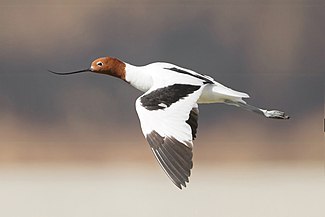Talk:Red-necked avocet
Appearance
(Redirected from Talk:Red-necked Avocet)
A fact from Red-necked avocet appeared on Wikipedia's Main Page in the Did you know column on 22 June 2012 (check views). The text of the entry was as follows:
|
Capitalization
[edit]I don't think the name of the bird should be capitalized in the text. We don't capitalize "pileated woodpecker", for example. --Kenatipo speak! 01:48, 22 June 2012 (UTC)
- err, yes we do. Casliber (talk · contribs) 04:16, 22 June 2012 (UTC)
- I stand corrected. (Now I'll go to my grave wondering whether the bald eagles I read and heard about were Bald Eagles or just eagles whose hair fell out.
 ) --Kenatipo speak! 15:18, 23 June 2012 (UTC)
) --Kenatipo speak! 15:18, 23 June 2012 (UTC)
- I stand corrected. (Now I'll go to my grave wondering whether the bald eagles I read and heard about were Bald Eagles or just eagles whose hair fell out.
- In general, according to Wikipedia:Naming conventions (fauna), common names of animals are not capitalized, except for those words which are a proper name – for example, North Atlantic right whale. However, for WP:WikiProject Birds, the adopted convention is to require capitalization of each word in the common name of a species (or subspecies). Refer to Wikipedia:Naming conventions (birds) for a detailed description of the rules. For the sake of completeness, capitalization is also permitted (but not required) for the common names of Lepidoptera (butterflies and moths) and Odonata (dragonflies and damselflies), but not for those of other insects or of other animals. Grollτech (talk) 05:51, 27 June 2012 (UTC)
File:Recurvirostra novaehollandiae in flight - Lake Joondalup.jpg to appear as POTD soon
[edit]Hello! This is a note to let the editors of this article know that File:Recurvirostra novaehollandiae in flight - Lake Joondalup.jpg will be appearing as picture of the day on August 11, 2013. You can view and edit the POTD blurb at Template:POTD/2013-08-11. If this article needs any attention or maintenance, it would be preferable if that could be done before its appearance on the Main Page. Thanks! — Crisco 1492 (talk) 09:06, 25 July 2013 (UTC)
The Red-necked Avocet (Recurvirostra novaehollandiae) is a wader of the family Recurvirostridae which feeds by skimming the surface of water to catch small invertebrates. Endemic to Australia, the species is rare in Tasmania and an occasional vagrant to New Zealand.Photograph: JJ Harrison
Categories:
- Wikipedia Did you know articles
- C-Class bird articles
- Low-importance bird articles
- WikiProject Birds articles
- C-Class Australia articles
- Low-importance Australia articles
- C-Class Australian biota articles
- Low-importance Australian biota articles
- WikiProject Australian biota articles
- WikiProject Australia articles






